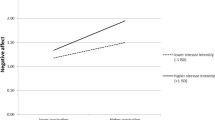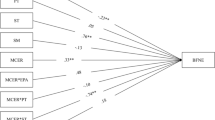Abstract
Recent studies have begun to document the diversity of ways people regulate their emotions. However, one unanswered question is why people regulate their emotions as they do in everyday life. In the present research, we examined how social context and goals influence strategy selection in daily high points and low points. As expected, suppression was particularly tied to social features of context: it was used more when others were present, especially non-close partners, and when people had instrumental goals, especially more interpersonal ones (e.g., avoid conflict). Distraction and reappraisal were used more when regulating for hedonic reasons (e.g., to feel better), but these strategies were also linked to certain instrumental goals (e.g., getting work done). When contra-hedonic regulation occurred, it primarily took the form of dampening positive emotion during high points. Suppression was more likely to be used for contra-hedonic regulation, whereas reappraisal and distraction were used more for pro-hedonic regulation. Overall, these findings highlight the social nature of emotion regulation and underscore the importance of examining regulation in both positive and negative contexts.




Similar content being viewed by others
Notes
While these data technically have a 3-level structure (where level 1 = high/low event, level 2 = day, and level 3 = participant), implementing a three-level model requires a minimum of 20–30 clusters at level 2 (Snijders and Bosker, 1999). This was not feasible due to the small number of level-2 clusters (i.e., n = 7 days). In addition, when using a subset of regulated events, most variance in goals and strategies was observed at levels 1 and 3, with 0–7% at level 2; this variance distribution further supports collapsing across level 2 units and implementing a two-level analysis.
References
Aldao, A. (2013). The future of emotion regulation research: Capturing context. Perspectives on Psychological Science, 8, 155–172.
Aldao, A., Sheppes, G., & Gross, J. J. (2015). Emotion regulation flexibility. Cognitive Therapy and Research, 39, 263–278.
Blalock, D. V., Kashdan, T. B., & Farmer, A. S. (2016). Trait and daily emotion regulation in social anxiety disorder. Cognitive Therapy and Research, 40, 416–425.
Bonanno, G. A., & Burton, C. L. (2013). Regulatory flexibility: An individual differences perspective on coping and emotion regulation. Perspectives on Psychological Science, 8, 591–612.
Brans, K., Koval, P., Verguyn, P., Lim, Y. L., & Kuppens, P. (2013). The regulation of negative and positive affect in daily life. Emotion, 5, 926–939.
Butler, E. A., Egloff, B., Wilhelm, F. W., Smith, N. C., Erickson, E. A., & Gross, J. J. (2003). The social consequences of expressive suppression. Emotion, 3, 48–67.
Charles, S. T., Piazza, J., Luong, G., & Almeida, D. M. (2009). Now you see it, now you don’t: Age differences in affective reactivity to social tensions. Psychology and Aging, 24, 645–653.
Edwards, L. J., Muller, K. E., Wolfinger, R. D., Qaqish, B. F., & Schabenberger, O. (2008). An R2 statistic for fixed effects in the linear mixed model. Statistics in Medicine, 27, 6137–6157.
Ekman, P. (1972). Universals and cultural differences in facial expressions of emotion. In J. Cole (Ed.), Nebraska symposium on motivation (pp. 207–283). Lincoln, NE: University of Nebraska Press.
Enders, C. K. (2001). A primer on maximum likelihood algorithms available for use with missing data. Structural Equation Modeling, 8, 128–141.
English, T., & Carstensen, L. L. (2014). Selective narrowing of social networks across adulthood is associated with improved emotional experience in daily life. International Journal of Behavioral Development, 38, 195–202.
English, T., John, O. P., & Gross, J. J. (2013). Emotion regulation in relationships. In J. A. Simpson & L. Campbell (Eds.), Handbook of close relationships (pp. 500–513). Oxford: Oxford University Press.
Graham, J. W. (2009). Missing data analysis: Making it work in the real world. Annual Review of Psychology, 60, 549–576.
Gross, J. J. (1998). Antecedent- and response-focused emotion regulation: Divergent consequences for experience, expression, and physiology. Journal of Personality and Social Psychology, 74, 224–237.
Gross, J. J. (2014). Handbook of emotion regulation (2nd ed.). New York: Guilford Press.
Gross, J. J., & John, O. P. (2003). Individual differences in two emotion regulation processes: Implications for affect, relationships, and well-being. Journal of Personality and Social Psychology, 85, 348–362.
Gross, J. J., & Levenson, R. W. (1997). Hiding feelings: The acute effects of inhibiting negative and positive emotion. Journal of Abnormal Psychology, 106, 95–103.
Gross, J. J., Richards, J. M., & John, O. P. (2006). Emotion regulation in everyday life. In D. K. Snyder, J. A. Simpson, & J. N. Hughes (Eds.), Emotion regulation in families: Pathways to dysfunction and health (pp. 13–35). Washington, DC: American Psychological Association.
Gross, J. J., Sheppes, G., & Urry, H. L. (2011a). Emotion generation and emotion regulation: A distinction we should make (carefully). Cognition and Emotion, 25, 765–781.
Gross, J. J., Sheppes, G., & Urry, H. L. (2011b). Taking one’s lumps while doing the splits: A big tent perspective on emotion generation and emotion regulation. Cognition and Emotion, 25, 789–793.
Gyurak, A., Gross, J. J., & Etkin, A. (2011). Explicit and implicit emotion regulation: A dual-process framework. Cognition and Emotion, 25, 400–412.
Heiy, J. E., & Cheavens, J. S. (2014). Back to basics: A naturalistic assessment of the experience and regulation of emotion. Emotion, 14, 878–891.
Hox, J. (2002). Multilevel analysis: Techniques and applications. Mahwah, NJ: Erlbaum.
Kashdan, T. B., Goodman, F. R., Mallard, T. T., & DeWall, C. N. (in press). What triggers anger in everyday life? Links to the intensity, control, and regulation of these emotions, and personality traits. Journal of Personality.
Kim, M. Y., Ford, B. Q., Mauss, I., & Tamir, M. (2014). Knowing when to seek anger: Psychological health and context-sensitive emotional preferences. Cognition and Emotion, 29(6), 1126–1136.
Mauss, I. B., Bunge, S. A., & Gross, J. J. (2007). Automatic emotion regulation. Social and Personality Psychology Compass, 1, 146–167.
Mauss, I. B., & Tamir, M. (2013). Emotion goals: How their content, structure, and operation shape emotion regulation. In J. J. Gross (Ed.), Handbook of emotion regulation (2nd ed., pp. 361–375). New York, NY: Guilford Press.
McRae, K., Heller, M., John, O. P., & Gross, J. J. (2011). Context-dependent emotion regulation: Suppression and reappraisal at the Burning Man Festival. Basic and Applied Social Psychology, 33, 346–350.
McRae, K., Hughes, B., Chopra, S., Gabrieli, J. D., Gross, J. J., & Ochsner, K. N. (2010). The neural bases of distraction and reappraisal. Journal of Cognitive Neuroscience, 22, 248–262.
Nezlek, J. B., & Kuppens, P. (2008). Regulating positive and negative emotions in daily life. Journal of Personality, 76, 561–579.
Parrott, W. G. (1993). Beyond hedonism: Motives for inhibiting good moods and for maintaining bad moods. In D. M. Wegner & J. W. Pennebaker (Eds.), Handbook of mental control (pp. 278–308). Englewood Cliffs, NJ: Prentice Hall.
Richards, J. M., & Gross, J. J. (2000). Emotion regulation and memory: The cognitive costs of keeping one’s cool. Journal of Personality and Social Psychology, 79, 410–424.
Riediger, M., Shmiedek, F., Wagner, G. G., & Lindenberger, U. (2009). Seeking pleasure and seeking pain: Differences in prohedonic and contra-hedonic motivation from adolescence to old age. Psychological Science, 20, 1529–1535.
Shaver, P. R., & Mikulincer, M. (2007). Adult attachment strategies and the regulation of emotion. In J. J. Gross (Ed.), Handbook of emotion regulation (pp. 446–465). New York: Guilford Press.
Sheppes, G., & Meiran, N. (2008). Divergent cognitive costs for online forms of reappraisal and distraction. Emotion, 8, 870–874.
Sheppes, G., Scheibe, S., Suri, G., Radu, P., Blechert, J., & Gross, J. J. (2014). Emotion regulation choice: A conceptual framework and supporting evidence. Journal of Experimental Psychology: General, 143, 163–181.
Snijders, T., & Bosker, R. (1999). Multilevel analysis. London: Sage Publications.
Srivastava, S., Tamir, M., McGonigal, K. M., John, O. P., & Gross, J. J. (2009). The social costs of emotional suppression: A prospective study of the transition to college. Journal of Personality and Social Psychology, 96, 883–897.
Tamir, M. (2009). What do people want to feel and why?: Pleasure and utility in emotion regulation. Current Directions in Psychological Science, 18, 101–105.
Tamir, M. (2016). Why do people regulate their emotions? A taxonomy of motives in emotion regulation. Personality and Social Psychology Review, 20, 199–222.
Webb, T. L., Miles, E., & Sheeran, P. (2012). Dealing with feeling: A meta-analysis of the effectiveness of strategies derived from the process model of emotion regulation. Psychological Bulletin, 138, 775–808.
Acknowledgements
This study was funded by National Institutes of Health (Grant Number MH58147).
Author information
Authors and Affiliations
Corresponding author
Ethics declarations
Conflict of interest
Tammy English, Ihno A. Lee, Oliver P. John, James J. Gross declare that they have no conflict of interest.
Ethical approval
All procedures performed in studies involving human participants were in accordance with the ethical standards of the institutional and/or national research committee and with the 1964 Helsinki declaration and its later amendments or comparable ethical standards.
Informed consent
Informed consent was obtained from all individual participants included in the study.
Rights and permissions
About this article
Cite this article
English, T., Lee, I.A., John, O.P. et al. Emotion regulation strategy selection in daily life: The role of social context and goals. Motiv Emot 41, 230–242 (2017). https://doi.org/10.1007/s11031-016-9597-z
Published:
Issue Date:
DOI: https://doi.org/10.1007/s11031-016-9597-z




